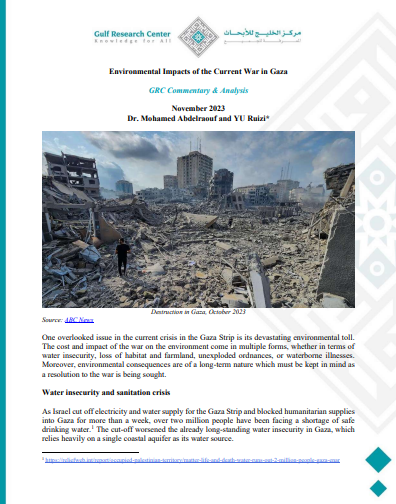
Destruction in Gaza, October 2023 Source: ABC News
One overlooked issue in the current crisis in the Gaza Strip is its devastating environmental toll. The cost and impact of the war on the environment come in multiple forms, whether in terms of water insecurity, loss of habitat and farmland, unexploded ordnances, or waterborne illnesses. Moreover, environmental consequences are of a long-term nature which must be kept in mind as a resolution to the war is being sought.
Water insecurity and sanitation crisis
As Israel cut off electricity and water supply for the Gaza Strip and blocked humanitarian supplies into Gaza for more than a week, over two million people have been facing a shortage of safe drinking water.1 The cut-off worsened the already long-standing water insecurity in Gaza, which relies heavily on a single coastal aquifer as its water source.
According to the 2020 environmental assessment for the occupied Palestinian territory conducted by UNEP, water scarcity has been an issue in Gaza, since only 4% of the water, 180 million m3, extracted from the sea is potable on an annual basis.2 It is estimated that 97% of the water in Gaza is below the World Health Organization standard for human consumption due to untreated or insufficiently treated sewage.3
So far, the contamination and depletion of water have been further exacerbated due to infrastructure collapse and suspension of power supply during the ongoing hostilities. Damages on public water supply systems, wastewater treatment facilities, and drainage networks could be substantial due to recurring bombardments, a lesson not heeded from the Israeli aggression against the Gaza Strip in 2021 when 17,200 metres of sewage networks and 12 sewage pumping stations were destroyed to different extents.4 Additionally, the leakage of hazardous oil from demolished plants into surface and groundwater would bring risks of soil erosion and trigger long-term health disasters including sanitation crises and the spread of waterborne diseases.
Loss of habitat and farmland
As is evidenced by a group of satellite images taken from the U.S. space technology firm Maxar Technologies on October 10, recent airstrikes by Israel have caused extensive devastation to residential buildings in the Gaza Strip.5 The scale of destruction has been exponential, with Israel releasing a series of evacuation warnings and targeting hospitals and schools.6 Heavy bombardment results in a loss of human habitat as well as a surge of air pollution, as toxic and hazardous compounds are released into the environment from the burning buildings, especially those from industrial facilities.
In addition to buildings, green spaces and agricultural lands have also been heavily damaged. Since 1967, military actions of the Israeli government have induced the uprooting of over 2.5 million trees in the occupied Palestine territories, among which were more than one million olive trees - an essential source of income in the region.7 The destruction of native trees and crops has worsened habitat fragmentation of local species and accelerated biodiversity loss and desertification in Gaza. The rockets and missiles not only cause immediate humanitarian crises and property damage but can also have long-lasting hazardous impacts. Specifically, the toxic residues including those from metals, plastic, and electronic waste heavily contaminate the soil with wide-spreading pollution in the local farmland.8 As a result, the agricultural areas suffer from desertification, soil erosion, and land degradation.9
The long-term contamination is hardly reversible in Gaza due to a severe lack of political stability, professional personnel, environmental legislation, and effective environmental governance. Regarding this point, a report by the UN Development Program Office in Ramallah (UNDP/PAPP) about the impacts of the Israeli offensive in Gaza from December 2008 to January 2009 showcased that 17% of the total cultivated land was completely ruined with little feasibility of rejuvenation.10 Worse still, the loss of farmlands as a major means of livelihood for local households further exacerbates the economic and environmental vulnerability of Gaza.
Unexploded ordnances (UXO) and long-term risks
Numerous confrontations as well as military training over the past several decades have continuously left behind risks of unpredictable explosions and long-term environmental damage to populated areas in Gaza due to the presence of an unknown quantity of underground UXOs left in its aftermath. The current war will only increase the number of UXOs, widening the highly dangerous and pollutant minefield. As reported by the United Nations Office for the Coordination of Humanitarian Affairs (OCHA), in the year after the UN-sponsored ceasefire in August 2006, 27 people died and over 146 were wounded as a result of UXOs. Moreover, studies show that the extreme heat of combustion could change both the physical structure and chemical properties of the soil, which consequently diminishes fertility and increases the risk of soil-borne diseases.11
Buried bodies and waterborne illness
According to the statistics published by Gaza’s Ministry of Health on October 23, the current war in the Gaza Strip has led to a death toll of more than 8,000, nearly 40% of which are children.12 Due to the relentless bombardment of residential buildings, schools, and hospitals within a short period, the burial of bodies has to depend on mass graves while most cannot be buried in a timely manner—even ice cream trucks are used to temporarily store corpses.13 According to the World Health Organization and Médicine Sans Frontières, while buried or decayed bodies do not generally lead to epidemics if they contain any highly infectious disease such as plague or typhus, diseases can possibly be spread via fleas or lice.14 Additionally, fecal materials from the bodies can leak, causing contamination of drinking water and leading to waterborne illnesses such as diarrhea,15 which will worsen water insecurity issues already faced by Gaza.
Ecological damage and immense costs
Historical data in the occupied Palestine territory have clearly shown that environmental damages generated by the escalation of hostilities can be enormous. The environmental assessment of the Gaza Strip conducted by UNEP after the violence in December 2008 and January 2009 suggested a total environmental cost of USD 44 million. The major components are “removal and safe disposal of rubble and asbestos” and “cost associated with dealing with the damages and suspected contamination of agricultural land.”16
However, despite the assessment and promotion efforts of UNEP in 2003, 2005, 2009, and 2020, these findings have attracted little media attention. Meanwhile, according to the 2020 assessment report, the environmental governance in Gaza has been highly deficient due to ineffective cooperation between Israel and the occupied Palestine territory, overlapping activities of numerous institutions, and insufficient capability and resources of Gaza.17 As the 2023 Israel-Hamas war continues, environmental costs are expected to reach another peak and the gloomy environmental governance could further deteriorate.
Conclusion
In addition to immediate casualties in the current war, huge ecological damages could potentially cause even greater loss of life over time. Since air and water pollution as well as soil contamination transgress geopolitical boundaries and affect natural resources and ecosystems globally, the farreaching impacts would persist across generations and thus impact not only the Middle East but humanity on a wider scale. Therefore, it is vital to recognize the urgency of environmental preservation and ecological responsibility even amid warfare. Once conflicts cease, collaboration among the United Nations and the international community becomes crucial for launching and scaling up reconstruction and rehabilitation efforts. The collective commitment to post-war environmental restoration will contribute to a sustainable and resilient future by rebuilding the linkage of global well-being and environmental governance.
*Dr. Mohamed Abdelraouf is the Director of the Environmental Security and Sustainability Research Program at the Gulf Research Center, and YU Ruizi is a Master’s Candidate at the Geneva Graduate Institute
2 https://ceobs.org/un-report-details-environmental-degradation-in-west-bank-and-gaza/
7 https://imeu.org/article/environmental-apartheid-in-palestine
9 https://ceobs.org/un-report-details-environmental-degradation-in-west-bank-and-gaza/

